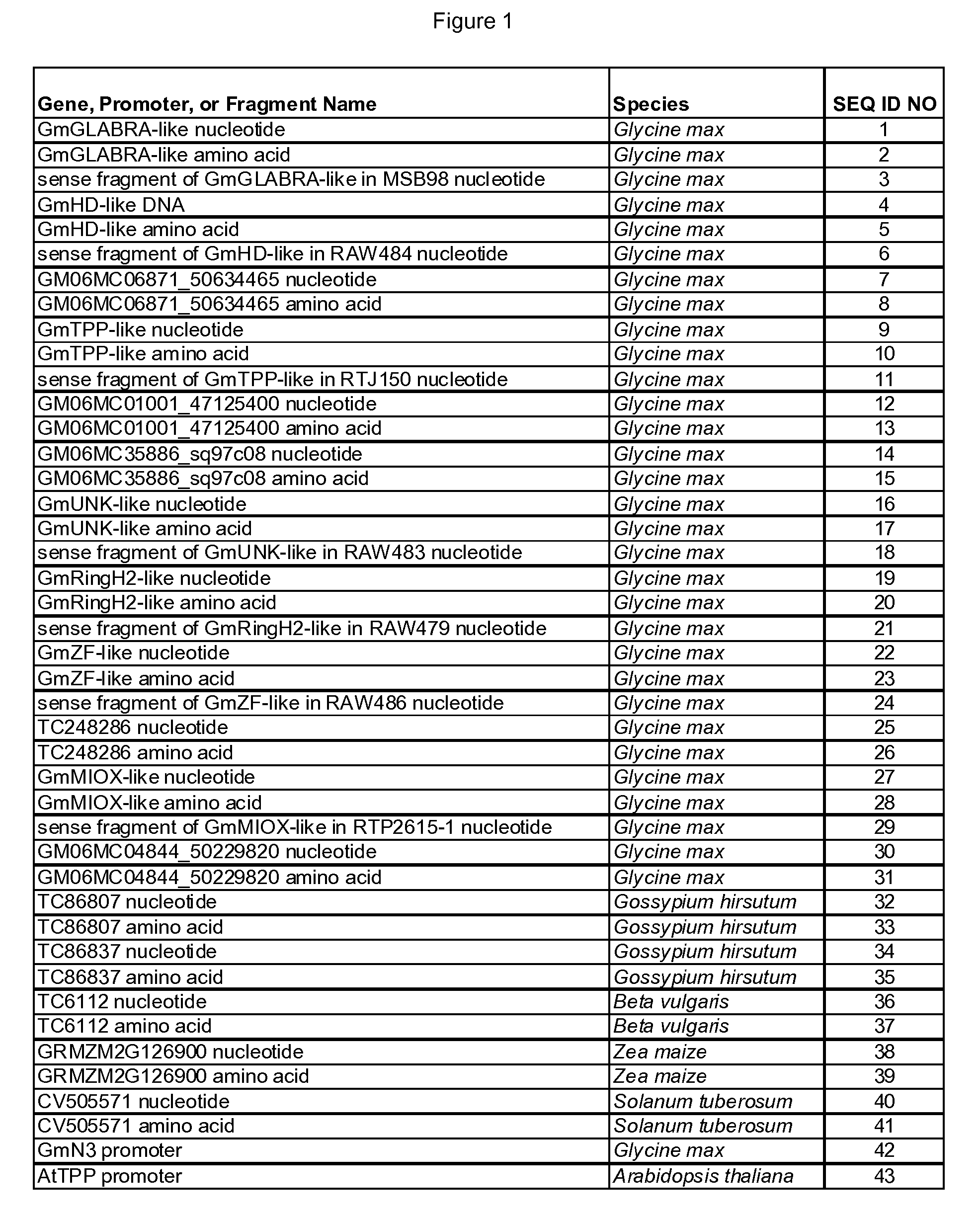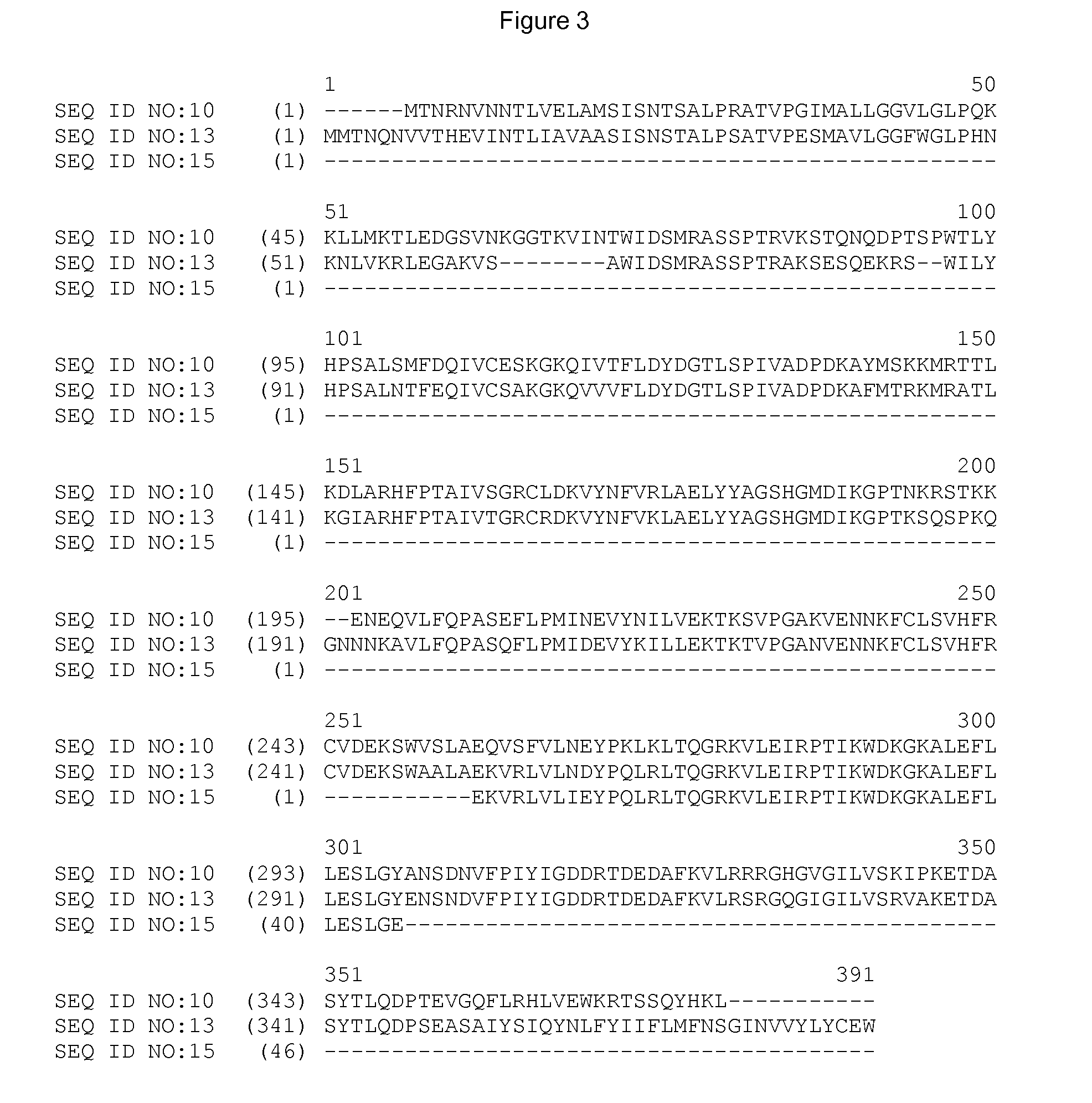Nematode-resistant transgenic plants
a transgenic plant, nematode technology, applied in the direction of plant genotype modification, fermentation, biochemistry apparatus and processes, etc., can solve the problems of large losses in susceptible crops, large loss of target genes, and estimated $100 billion crop loss worldwide, and achieve the effect of inhibiting the expression of target genes
- Summary
- Abstract
- Description
- Claims
- Application Information
AI Technical Summary
Benefits of technology
Problems solved by technology
Method used
Image
Examples
example 1
Cloning of Target Genes and Vector Construction
[0077]Using available cDNA clone sequence for the soybean target genes, PCR was used to isolate DNA fragments approximately 200-500 bp in length that were used to construct the binary vectors described in Table 1 and discussed in Example 2. The PCR products were cloned into TOPO pCR2.1 vector (Invitrogen, Carlsbad, Calif.) and inserts were confirmed by sequencing. Gene fragments for the target genes GmTPP-like, GmGLABRA-like, and GmMIOX-like were isolated using this method. Alternatively, available cDNA clone sequence for the soybean target gene was used to identify DNA fragments approximately 200-300 bp in length that were used to construct the binary vectors described in Table 1 and discussed in Example 2. The identified DNA sequences for the soybean target genes were synthesized, cloned into a pUC19 (Invitrogen) vector, and verified by sequencing. Gene fragments for the target genes GmHD-like, GmRingH2 Finger-like, GmUNK, and GmZF-li...
example 2
Bioassay of dsRNA Targeted to G. Max Target Genes
[0081]The binary vectors described in Table 1 were used in the rooted plant assay system disclosed in commonly owned copending U.S. Pat. Pub. 2008 / 0153102. Transgenic roots were generated after transformation with the binary vectors described in Example 1. Multiple transgenic root lines were sub-cultured and inoculated with surface-decontaminated race 3 SCN second stage juveniles (J2) at the level of about 500 J2 / well. Four weeks after nematode inoculation, the cyst number in each well was counted. For each transformation construct, the number of cysts per line was calculated to determine the average cyst count and standard error for the construct. The cyst count values for each transformation construct was compared to the cyst count values of an empty vector control tested in parallel to determine if the construct tested results in a reduction in cyst count. Bioassay results of constructs containing the hairpin stem sequences describ...
example 3
Identification of Additional Soybean Sequences Targeted by Binary Constructs
[0082]As disclosed in Example 2, the construct RAW484 results in the expression of a double stranded RNA molecule that targets SEQ ID NO:4 and results in reduced cyst count when operably linked to a SCN-inducible promoter and expressed in soybean roots. The sense fragment of the GmHD-like gene contained in RAW484, described by SEQ ID NO:6, corresponds to nucleotides 592 to 791 of the GmHD-like sequence described by SEQ ID NO:4. At least one of the resulting 21 mers derived from the processing of the double stranded RNA molecule expressed from RAW484 can target another soybean sequence described by SEQ ID NO:7. The amino acid alignment of the identified targets of the double stranded RNA molecule expressed from RAW484 described by the GmHD-like target gene SEQ ID NO:5 and GM50634465 described by SEQ ID NO:8 is shown in FIG. 2. The nucleotide alignment of the identified targets of the double stranded RNA molec...
PUM
| Property | Measurement | Unit |
|---|---|---|
| length | aaaaa | aaaaa |
| resistance | aaaaa | aaaaa |
| nematode resistance | aaaaa | aaaaa |
Abstract
Description
Claims
Application Information
 Login to View More
Login to View More - R&D
- Intellectual Property
- Life Sciences
- Materials
- Tech Scout
- Unparalleled Data Quality
- Higher Quality Content
- 60% Fewer Hallucinations
Browse by: Latest US Patents, China's latest patents, Technical Efficacy Thesaurus, Application Domain, Technology Topic, Popular Technical Reports.
© 2025 PatSnap. All rights reserved.Legal|Privacy policy|Modern Slavery Act Transparency Statement|Sitemap|About US| Contact US: help@patsnap.com



